Market conditions have been unkind to business aviation over the past 18 months. The worst recession for seven decades forced one of the most drastic declines in business aviation manufacturing history as cash-strapped customers were forced to defer or cancel aircraft purchases, or find cheaper alternatives on the used aircraft market.
Orderbooks are the barest they have been for years, leaving the airframers with little alternative but to slash their workforces - by up to 50% in some cases - to compensate for the low production rates.
"Business aircraft have been hit harder by the economic crisis than any other aerospace market," says Richard Aboulafia, aerospace analyst with the US Teal Group. "After unprecedented growth [in 2006 and 2007], the market fell by 24.3% [in value of deliveries], he says. Aboulafia is confident, however, that the decline is over. "The good news is that the market has stopped falling, and some of the leading indicators offer encouragement."
 |
|---|
© PiaggioPiaggio is exploring new designs and upgrades including an evolution of the Avanti II |
One such indicator is UBS Investment Research's Business Jet Market Index, which charted a rise in market conditions to 50 in March, on a scale of 0-100, indicating a return to stability after the figure plummeted in November 2008 to an all-time low of 13. UBS analysts say the gain reflects improving customer interest in private aviation and bolsters their predictions that 2010 will be better than 2009 despite the glut of pre-owned jets that continues to weigh on the market.
But Aboulafia cautions that the downturn is likely to span three years.
 | |
|---|---|
"The most unusual aspect of the market now is the unprecedented bifurcation"Richard AboulafiaTeal Group aerospace analyst | |
Read the Teal Group 20th Annual Business Aircraft Market Forecast And Industry Overview in full |
The key driver - corporate profits - shows only limited signs of a recovery, he suggests. "Used aircraft prices remain weak [particularly at the bottom end of the market] and it will take some time to reduce high inventories of available jets."
Aboulafia's pessimism is translated in his latest market forecast for the industry - to be published at EBACE - in which he predicts 13,965 aircraft worth $233 billion will be delivered over the next 10 years. This includes 10,285 business jets worth $184.1 billion, 649 corporate versions of jetliners and regional jets worth a combined total of $36.4 billion, and 3,031 business turboprops worth $13.2 billion. This contrasts with the previous 10 years, in which 10,874 business aircraft worth $170.7 billion were produced - 7,889 jets worth $143.4 billion, 397 jetliners and regional jets worth $16.1 billion, and 2,589 turboprops worth $11.2 billion.
"The most unusual aspect of the market now is the unprecedented bifurcation of market behaviour," he says. "The top half of the market - jets costing $25 million and above - barely felt any pain last year, with deliveries falling a mere 4.1%. The bottom half - jets costing $4-24 million - fell by a catastrophic 42.8%. The market has never seen bifurcation like this in any previous downturn or growth spurt."
After 2012, Teal's "conservative" forecast calls for a six-year recovery period with 10% growth each year. "Our conservatism is largely based on the likelihood of greater financial caution in the aftermath of the global credit crisis of 2008-09. Unfortunately, with this growth rate we won't see a recovery to the 2008 peak deliveries level until 2016-17."
Aboulafia is confident the anti-business jet sentiment that dominated the political and public arenas in the aftermath of the downturn will not persist as a damper on demand. "Preference for, and acceptance of, business aircraft will return as world economic growth resumes. Also, the past 14 years have seen business aviation transformed from a backwater market to a key part of the aerospace industry. This transformation will not be reversed. Even at the low point of our forecast, the business jet industry will be well over twice as large as it was in any year before 1997."
BOMBARDIER
"Twelve months ago we were in the middle of a deep recession that nobody was prepared for," says Steve Ridolfi, president of Bombardier Business Aircraft, "but we are starting to work our way out of it."
Bombardier - maker of the Challenger, Global and Learjet families of business jets - delivered 176 aircraft in its last fiscal year and is looking to deliver around 15% fewer aircraft this year. Bombardier also had 186 cancellations in its 2009-10 fiscal year. This rate is slowing, Ridolfi suggests, with only 26 cancellations recorded in the fourth quarter. The company's white tail tally has also fallen considerably, from 30 at its peak to seven by the end of the year. " All things considered," Ridolfi says, "we have done pretty well."
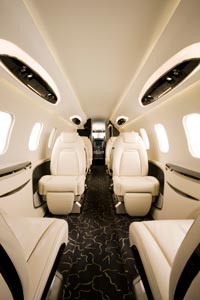 |
|---|
© BombardierThe Learjet 85 is due to enter service in 2013 |
He says that although the financial impact has been felt across all types, the diversity of Bombardier's product line has helped to cushion the blow. "There is tremendous breadth in our aircraft range and we have good and newish products in most segments."
Ridolfi says Bombardier has fostered a "solid product development strategy" to stimulate and retain customer interest in its family and to secure market dominance in its respective market sectors.
Bombardier is hoping to steal a march on its rivals with the Learjet 85 - a full-scale mock-up of which will be on display at EBACE. The eight-passenger midsize business jet - for which Bombardier has secured 60 firm orders - is the first clean-sheet Learjet design in more than a decade. It is also the first all-new platform launched by the Canadian airframer since its super-midsize Challenger 300 in 2000 and the first all-composite business jet to be certificated under US Federal Aviation Administration Part 25 rules.
Ridolfi says the Pratt & Whitney Canada PW307B-powered Learjet 85 is expected to be the airframer's largest, fastest - at Mach 0.82 - and most expensive Learjet model when its enters service in 2013. The detailed design phase is under way, as is construction of the factory at Bombardier's Mexico Manufacturing Centre in Queretaro, where all the major components including the wing and fuselage will be built. Mexico will also manufacture electrical harnesses and be responsible for subassembly systems installation.
Bombardier is also evaluating a new aircraft "at the top of the product line". Ridolfi declines to be drawn on a potential launch date for the aircraft and dismisses suggestions that Bombardier needs to hit back quickly at Gulfstream's longer-legged, faster G650, which is earmarked for service entry in 2012. "It is Gulfstream which is responding to the Global Express," Ridolfi says. The Global family is "eight to 10 years into its product cycle and from nowhere its has secured a significant 35% share of the super-large and ultra-long-range markets", he says.
 |
|---|
"There is an inherent loyalty to the Global family," Ridolfi adds. "Long-range aircraft are fundamental to the globalisation of business aviation and they will help to drive our future."
Part of this future will include a corporate version of its CSeries airliner, which enters service in 2013. "A lot of customers have expressed interest in this aircraft, we will definitely do it," Ridolfi says. Bombardier expects to have its new Global Vision flightdeck for the aircraft certificated by early 2011. The flightdeck incorporates a new integrated avionics suite based on Rockwell Collins' new Pro Line Fusion architecture in place of the legacy Honeywell Primus 2000XP.
While product development is core to Bombardier's strategy, Ridolfi says the airframer "has moved the needle on customer satisfaction" by investing in its international support and delivery infrastructure. "New markets are crucial to our growth and are the way of the future," he adds.
The shift in focus to international markets has been dramatic. Five years ago the US market accounted for 80% of Bombardier's business aircraft sales, with international markets soaking up the remainder. Ridolfi says international sales have rocketed to 70% of Bombardier's tally. "Progress is still being made in the USA, but emerging markets such as India, China and elsewhere in the Asia Pacific will be the growth engines," he adds.
CESSNA
This view is echoed by Cessna, which has seen international sales climb to around 50% of its overall business compared with around 30% five years ago.
The airframer - maker of the Citation series of business jets, with more than 6,000 of the types delivered to date - has been hit hard by the downturn, mainly because of its dominance in the badly affected light-cabin business jet sector.
 |
|---|
© CessnaCessna's latest design, the CJ4, received US certification earlier this year |
"Last year was terribly rough for us," says Cessna president Jack Pelton. "We delivered 275 aircraft compared with 340 the previous year, but our original projection for 2009 [before the downturn struck] was 525 aircraft." Pelton blames the spending curb on the economic downturn and the destructive negative political and social rhetoric surrounding the use of business aircraft that surfaced in 2009.
"People simply stopped buying aircraft. We were forced to cut production rates across all our models to bring supply in line with demand, and cut 50% of the workforce," he says.
The plummeting values of used aircraft - particularly in the light and mid-size sectors - also drove down sales. "The prices of pre-owned aircraft were terrible for us. People were asking 'why buy new when I can get a two-year-old aircraft so much cheaper?"
He says that used inventories are shrinking and that prices are starting to stabilise. "Cessna will ride out 2010," and will deliver around 225 Citations, Pelton says. "We hope to see recovery in 2011."
Despite the torrid conditions, Cessna has continued to invest in research and design with a view to bringing new products to market. Its latest design, the CJ4, received US certification earlier this year and entered service this month. The Williams International FJ44-4A-powered light business jet - which replaces the Encore + - offers a Rockwell Collins Pro Line 21 flightdeck, a modestly swept wing, a maximum cruise speed of more than 450kt (840km/h) and a range of nearly 3,700km (2,000nm) with two crew and five passengers.
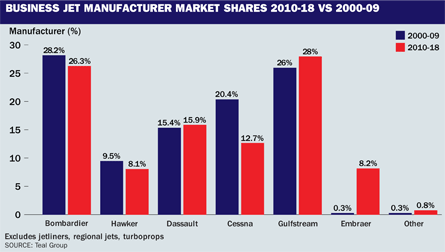 |
|---|
"We are constantly investing in new product design," Pelton says. "We plan to announce upgrades to aircraft at NBAA and later down the line will launch at least two clean-sheet designs."
Pelton has not ruled out reviving the Columbus large-cabin jet programme, development of which was shelved in 2009 because of the poor economic conditions. "We were always careful not to walk away from the Columbus as our fleet line calls for a large aircraft to sit at the top," Pelton says.
Meanwhile, Cessna is continuing to expand into new markets in an attempt to drive up new sales and is continuing to counteract the negative publicity surrounding business aircraft. "We can't just wait for a crisis," Pelton says. "There has to be an ongoing grassroots campaign to knock back the critics and make them understand the value of business aviation."
DASSAULT
Tough trading conditions have forced Dassault to delay the launch of its new super-midsized Falcon business jet.
The "Future Falcon", to be powered by the 10,000lb-thrust (45kN) Rolls-Royce RB282-3 engine, is intended to replace the out-of-production Falcon 50EX at the bottom of the manufacturer's range. However, Dassault is still to commit to a timeframe for the jet, after a year in which its new orders were far outweighed by cancellations.
Dassault's Falcon orders fell from a positive total of 115 units in 2008 to a negative one of 163 in 2009, as fractional ownership provider NetJets cancelled 65 aircraft due to arrive post-2014.
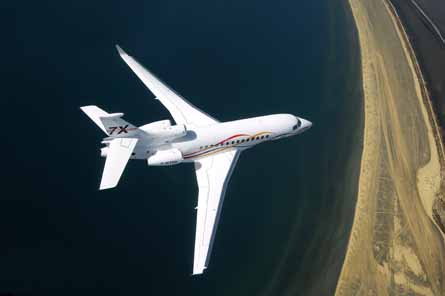 |
|---|
© Dassault |
The manufacturer could take some comfort in a year of record deliveries. The total, at 77 units, was up five on 2008, and the manufacturer is sticking to its prediction of a fresh record in 2010, forecasting 80 deliveries by the end of the year.
The ultra-large-cabin segment - in which the Falcon 7X
Nevertheless, the Dassault Falcon production rate of 5.5 aircraft a month is well below the 10 aircraft a month the manufacturer had been planning before the downturn kicked in. Last year, the slowdown in business jets led to furloughing of workers at Dassault's French factories and 150 layoffs at its US completions and delivery facility at Little Rock.
As a result of 2009's record deliveries and negative orders, Dassault's business jet backlog fell from 489 at the end of 2008 to 249 a year later. It expects no "meaningful recovery" in orders before 2012.
Against this backdrop, the manufacturer is focusing attention on emerging markets. "We have enjoyed, over the last few years, good market share in Brazil and India, in particular," says Rosanvallon. "We are also very active in China these days, but the sum of everything is not yet not strong enough to call it a real recovery."
 |
|---|
The downturn has also led the manufacturer to focus on its aftermarket operations, expanding its range of technical services and opening new service centres, particularly in Asia, where - Rosanvallon notes - "volumes are not huge yet but commercial activity has increased substantially over last two to three years".
EMBRAER
"Customer support is vital," says Claudio Camelier, Embraer's vice-president for market intelligence executive aviation. The Brazilian airframer has built a base of 34 services centres worldwide - five of which are company owned. "As our customer base expands, our priority is to build a strong infrastructure to support the Embraer business aircraft family," says Camelier.
He says the backlog for Embraer's Phenom Legacy and Lineage family remains healthy despite its suffering cancellations across the product line last year. "Lots of customers have asked for their orders to be postponed or cancelled so we have available positions this year," says Camelier.
 | 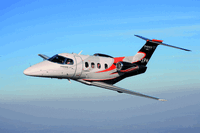 |
|---|---|
Although he declines to disclose the total cancellation tally, Camelier does reveal that European air taxi start-up JetBird - one of Embraer's largest fleet customers - rescinded its agreement to purchase 50 Phenom 100 very light jets as a result of funding constraints. The scope of the new contract has not been resolved, Camelier says, although a much slower delivery schedule is planned.
"The air taxi model only accounts for 15% of our Phenom 100 backlog anyway," Camelier adds. "We are not dependent on this model, but on the traditional business jet users."
Embraer says it grew its market share by revenue to 6.4% in 2009 from around 4% in previous years. In business jet deliveries, Embraer had a 14% market share, won by the Phenom family for which it has a backlog of 600.
The Brazilian airframer says that by the end of January it had delivered 100 Phenom 100s and two Phenom 300 light business jets, for which it received Brazilian and US certification in December and January, respectively. Embraer plans to increase production of the six-seat Phenom 300 this year, "but not by as much as we would have liked", Camelier says. "The crisis has impacted us but it could have been worse," Camelier admits. "We were about to ramp up production of the Phenom 100 [which had recently received certification], but we were able to quickly adjust to the new market scenario."
Embraer is still a relative newcomer to the business aviation market, having launched its offensive six years ago with the Legacy 600. Now it has an expanding family of seven business jets across the spectrum. Its latest family member, the Legacy 650, was launched last year as a rival to large-cabin entrants including the Bombardier Challenger 605, Dassault Falcon 2000LX, Gulfstream G350 and G450. The Rolls-Royce AE300-7A2-powered aircraft shares the same cabin as its 10-year-old Legacy 600 stablemate, but offers 925km of additional range and a Honeywell Primus Elite flightdeck - which will also be fitted to the super-midsize Legacy 600 at a later date, Embraer says.
Two aircraft are undergoing flight testing and the Legacy 650 is earmarked for certification and service entry later this year. Camelier says customers are more interested in the Legacy 650 than the smaller Legacy 600, given the price differential of only $2 million, and says the "market will decide if we should keep offering both aircraft types".
Embraer is also forging ahead with development of its mid-light Legacy 450 and midsize 500 business jets . Both clean-sheet aircraft have flat floors, stand-up cabins and fly-by-wire technology, which is unique for aircraft in their competing segments, says Embraer.
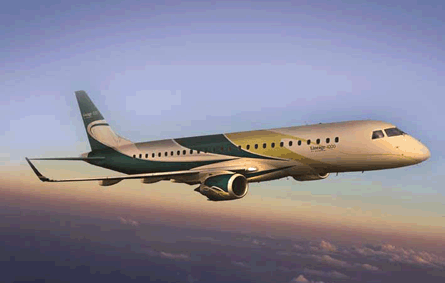 |
|---|
© Embraer |
First flight of the 500 is scheduled for the second half of 2011, leading to service entry in 2012. The 450 is expected to have its maiden flight at the end of 2012 leading to certification around a year later.
At the top of its range, the manufacturer offers its Embraer 190-derived Lineage 1000, for which it has around 20 orders. In 2009 it transferred completion of the ultra-large business jet from USA-based PATS - which has completed two aircraft and has one more to complete under contract - to Brazil.
"As with our other aircraft, we want to control the completions process," Camelier says. "This enables us increase efficiency, improve logistics and build more flexibility into the system." Five Lineage 1000s have been delivered to date and work on the six aircraft is under way.
Embraer will continue to explore new products, Camelier says, as there are still niches to exploit in its product line. "The business aviation market is brand loyal," he says. "The five established players have been in the business aviation arena for years, we are a relative newcomer."
Embraer made a strategic decision to enter the market at the lower end of the product line with the Phenom 100 and 300. "We want to introduce as many people as we can to the Embraer brand through the Phenom family as the customer base in the very light and light business aircraft sector is huge," Camelier says.
Meanwhile, he is conservative about market developments in the immediate future. "It will be several years before the market is fully back in balance," he says. On the used aircraft front, he believes "it is going to take at least two years to get to an historic level of 12-14% of the inventory" for sale.
Orders are expected to rebound in 2011, Camelier says, helping to increase deliveries, starting in 2012 when a second Phenom production line should be up and running in Melbourne, Florida.
EMIVEST AEROSPACE
Sino Swearingen Aircraft owner Emivest Aerospace has delivered two SJ30 light business jets since it became the majority owner in 2008. The first aircraft was delivered in September 2009 and the second in December to movie star Morgan Freeman. No more deliveries have been made as a result of "vendor issues" that the company declines to discuss.
 |
|---|
© Mark Donaghue |
Two SJ30s were delivered by the previous owner, which certificated the aircraft in 2005. Emivest - which bought an 80% share of the company from Taiwanese investors - says orders for the $7.25 million jet remain steady at 250.
GULFSTREAM
Gulfstream's orderbook took a knock in 2009, along with the airframer's delivery tally as demand for its midsize and large-cabin jets fell. Ninety-four aircraft were handed over in 2009 - 62 fewer than in 2008 - and Gulfstream expects to deliver 91 aircraft this year.
"Twelve months ago things weren't going well for us," says Gulfstream president Joe Lombardo. "The first half [of 2009] was pretty rough, with more cancellations than orders, so we took the production rates down. However, the second half ended on a positive note with more orders than cancellations."
 |
|---|
© Elite JetsElite Jets Gulfstream G450 |
The bulk of the interest is coming from the General Dynamics-owned company's large-cabin offerings, notably the G450 and G550, but the "crowded" midsize market is less buoyant, Lombardo admits, as it has been more affected by plunging used aircraft prices. However, he says "production rates are back to what they were last year - slow but steady - but we are not jumping in and ramping up."
Lombardo says "it is important to underscore that Gulfstream did not back off from product development" and "we are making great strides with the G250 and G650".
Launched in 2008, the ultra-long-range G650 is described as the largest non-airliner business jet. The aircraft has an array of sophisticated electronic systems for use by pilots and passengers and will have a maximum operating speed of Mach 0.92 - edging out the Citation X for the title of the world's fastest and largest business jet.
The first two of five Rolls-Royce BR-725-powered aircraft are undergoing flight testing at Gulfstream's Savannah, Georgia site and the airframer hopes to certificate and deliver the aircraft in 2011 and 2012 respectively
Development of the G250 - a replacement for the G200, formerly the Galaxy business jet - is running in parallel. The second aircraft - serial number 2002 - made its maiden flight late in March at co-developer Israel Aerospace Industries' Tel Aviv base. The super-midsize aircraft will be powered by Honeywell HTF7250Gs and will offer the PlaneView 250 flightdeck. It is set to enter service in 2011.
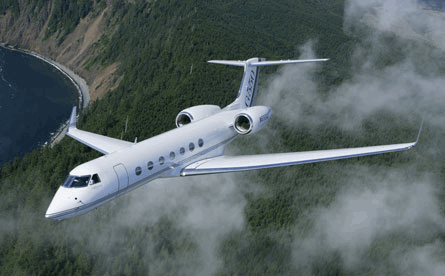 |
|---|
| © Gulfstream |
Gulfstream invests heavily in R&D, Lombardo says, and is looking at new technologies and platforms "that could be launched well into the decade". He refuses to be drawn on particular projects and potential launch dates, but industry sources have indicated that Gulfstream is planning to launch a clean-sheet successor to the G450 and G550, incorporating concepts and systems designed for the G650.
These sources say Gulfstream is in the midst of selecting a next-generation engine, thought to be either Pratt & Whitney Canada's PW800, General Electric's NG34 or an offering from Rolls-Royce.
HAWKER BEECHCRAFT
Product upgrades and derivatives rather than clean-sheet aircraft launches have been at the heart of Hawker Beechcraft'sstrategy for some time since the Hawker 4000 (née Horizon) super-midsize jet was introduced in 1996.
"We will continue to produce derivative models," says Sean McGeough, Hawker Beechcraft's vice-president for international sales. "We look at ways to increase the performance and reliability of our aircraft and reduce the operating costs for our customers," he adds.
There has been a flurry of activity in the past few months, most recently with the first flight of the Premier II light business jet at the airframer's Wichita base. The Premier II is an upgraded version of the six-seat Premier IA, itself a revamp of the Premier I that entered service in 2001.
The Premier II will have winglets - which increase wingspan by 330mm (13in) to 13.89m - and feature two 3,000lb-thrust Williams International FJ44-3AP engines, replacing the less powerful 2,290lb-thrust FJ44-2As of the Premier IA. The new model will have a 20% increase in range to 2,780km, with a pilot and four passengers. The aircraft is scheduled for service entry in 2013, says McGeough "when the market should be in recovery".
In January the US and European certification authorities approved the Rockwell Collins Venue-equipped Beechcraft King Air 350i turboprop. The 350 successor includes interior upgrades including improved lighting, reduced cabin sound levels, more space and more luxurious seats, says McGeough.
The 350i will be making its EBACE debut along with the C90GTX. This new entry-level King Air is equipped with winglets and with a higher payload and longer range, entered service in March, replacing the C90GTi - which entered service in late 2007. McGeough says sales of the King Air family of twin turboprops, which have been around since 1964 with more than 6,000 aircraft delivered, have held up well during the downturn, as a result of their versatility and widespread appeal.
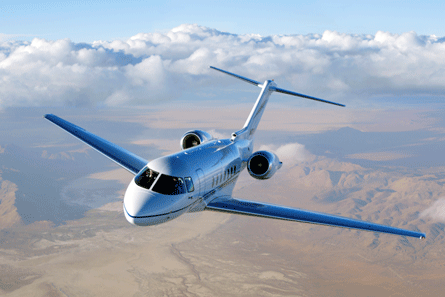 |
|---|
© Hawker Beechcraft |
"Many customers have chosen to downsize to the King Air to support their transport needs, while the aircraft is also becoming popular for special missions operations across the globe," he says.
The Hawker 4000, which entered service two years ago, "has been by far our greatest success story. We have delivered every aircraft we could build," McGeough says. In contrast, the market for the midsize 750 and 900XP has "not held up well", he admits. "The midsize sector has been squeezed by the downturn as it is very crowded, so the 750 and 900XP sales have been lagging," McGeough adds.
PIAGGIO
Fellow twin-turboprop maker Piaggio says it has been surprised the backlog for its Avanti II twin pusher has held up so well, given the devastation to its competitors' order tallies. "We delivered 24 aircraft in 2009 - 17% fewer than the previous year - and had five cancellations," says Piaggio's chief commercial officer Giuliano Felten.
He says the continued success of US fractional ownership company Avantair - which accounted for a quarter of Avanti II deliveries in 2009 - has helped to bolster its order tally. Felten says the attraction of the Avanti II for many operators is its fuel efficiency and image. "It burns up to 40% less fuel that its light jet competitors and has an image of efficiency and utility. Given the negative media surrounding business jets, these have become vital ingredients for many buyers," says Felten.
Piaggio is stepping up its sales activity to bolster its 71-aircraft backlog. "Before the crisis hit we were about to ramp up production to 40 aircraft a year," Felten says. Instead the Italian airframer was forced to "temporarily lay off" 25% of its workforce on 90% of pay. "It is vital we are able to sustain our workers as we do not want to lose their skill and experience when the market rebounds," Felten says.
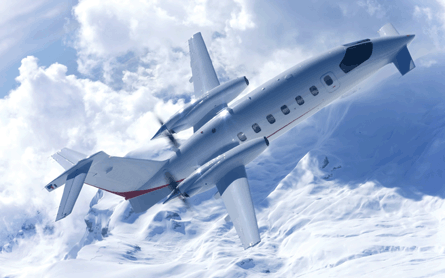 |
|---|
© Piaggio |
Piaggio is continuing to explore new aircraft designs and upgrades and recently launched a feasibility study looking at the evolution of the Avanti II. "We haven't figured out the extent of the upgrade as the Avanti II already incorporates new engines, avionics and interior. Our guidelines for the Avanti III are performance, range, speed and comfort," says Felten.
Piaggio is also working on a twin-engined business jet to complement its line-up and is in the process of securing risk-sharing partners and suppliers. "We want to have all the pieces of the puzzle in place before we launch the aircraft," Felten says.
AIRBUS
At the very top of the business aircraft spectrum the downturn has also presented its challenges. Airbus says it delivered 14 aircraft in 2009 and had no cancellations. Out of the total delivery tally, 12 aircraft were single-aisle Airbus Corporate Jetliners - the A318 Elite, A320 Prestige and ACJ - and two were from the A330/A340 family.
"We made record deliveries last year," says Airbus, "but new-order business is slow as the market seems to be adopting a wait-and-see approach."
Airbus is stepping up its marketing activity in Asia Pacific, notably in China, where it forecasts a demand for around five 15-plus-seat VIP aircraft a year. "China is the strongest market for the ACJ family now, while the Middle East is the largest market for VIP widebodies," says the European airframer.
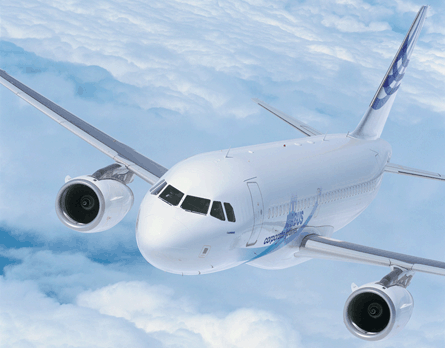 |
|---|
© Airbus |
BOEING
This view is supported by Boeing Business Jets, which says the Middle East accounts for 35% of its twin-aisle market. Steve Taylor, president of BBJ - which offers the BBJ, BBJ2, the 787-900-based BBJ3 and the BBJC family of corporate jets - says market conditions have been tough for the airframer, which delivered only four BBJs and one 777 in 2009.
This year the airframer plans year to deliver another 777 and up to seven BBJs, a figure that includes the Chinese-registered type handed over to charter operator Deer Jet in March.
"To be honest," Taylor says, "the boom times were so incredibly good that the current market is just a realistic correction."
He says that during the heady years of 2006 and 2007, BBJ was selling aircraft much faster than it could build them. "We were asking people to wait at least five years for a green BBJ. Now it is about three years," he says.
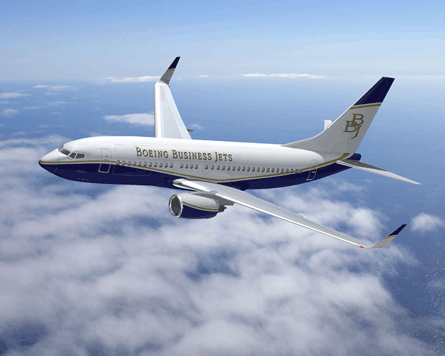 |
|---|
© Boeing |
Taylor - who is approaching his first anniversary at the helm of BBJ - says the company is "now eating into its backlog" of 28 BBJ types and 20 twin aisles, "but is now seeing signs of recovery. There seems to be more genuine interest in our product line and there seems to be more quality in the conversations we are having with potential customers," Taylor says.
In 2009 the company introduced the BBJC - a BBJ with a side cargo door - and has sold one aircraft to date. "The BBJC has attracted a great deal of interest, particularly from governments with multi-mission requirements," Taylor says. BBJ is also planning to offer by early next year an enhanced vision system for the BBJ that will be available initially as a retrofit.
TURBOPROPS
THE ECONOMIC slowdown has rocked the previously resilient single-engined turboprop market. While the quest for fuel-efficient, versatile, understated transport still prevails, demand for most of the these niche aircraft types has fallen over the past 12 months.
Pilatus Aircraft delivered a record number of PC-12NGs in 2009 at 100 aircraft - including the 900th type to an existing customer in the USA - but says "the volume of orders for business aircraft has fallen, and incoming orders remain sluggish".
The core market for the PC-12NG is executive owners - a group that traditionally accounts for around 85% of its market - but many have put their purchasing decisions on hold until the recovery is fully under way, Pilatus says.
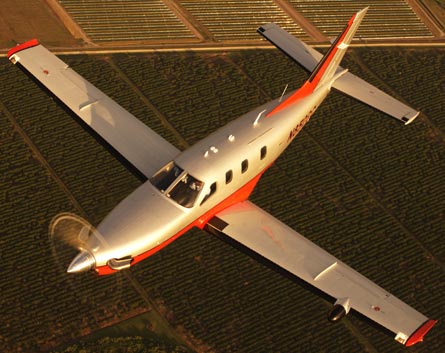 |
|---|
© Daher SocataDeliveries of TBM 850s in 2009 were 40% down on 2008's record year |
The Stans, Switzerland-based airframer will not disclose the size of its orderbook or its planned production rate for 2010, but says "it will try to get as close to 100 aircraft as it can". To offset the loss of its traditional market Pilatus has stepped up its sales effort in other key sectors, including air ambulance and military.
In 2009 Pilatus secured its first PC-12 fleet order from the Finnish air force and is planning to hand over all six aircraft this year. Pilatus is expanding geographically into potentially lucrative markets and will open a sales office in India in the coming months. The 1,000th PC-12 delivery is also expected this year.
Daher Socata delivered 36 TBM 850s in 2009 - around average for the French airframer in a typical year, but 40% down on the previous record year.
Socata blames the large used aircraft inventory and a lack of finance available to its buyers - mainly owner flyers - for the drop in sales, but says it has had few cancellations. Interest in the high-performance Pratt & Whitney Canada PT6A-66D-powered aircraft is starting to pick up.
"We hope to deliver 40 aircraft this year," the company says.
Piper Aircraft delivered 29 Meridians in 2009, compared with 52 in 2008, but says demand for the aircraft has remained relatively robust throughout the recession. "The Meridian is holding its place," says Piper marketing director Jackie Carlon. She says the typical customer for the Meridian historically has been the owner-flown community, including pilots with small companies who use their aircraft for business transport.
But Carlon says that recently Piper has seen demand from corporate flight departments that are looking for more efficient aircraft to complement their fleets. Companies have been looking for ways to continue to operate business aircraft, but not do something in which they would get "pinged for not being responsible", she says.
It is too early to say how many Meridian deliveries will result from this new segment because the business is evolving, but Piper is confident this is not a short-term phenomenon. Before "we didn't market to that audience. As time goes on I think we will. I don't see that going away."
The Cessna Caravan series has been targeted at commercial and utility operators from the start and this strategy has helped cushion the 26-year-old, single-engined turboprop from the economic fall-out. In 2009 Cessna delivered 100 Caravans and expects to hand over the same number in 2010. "This is a very rugged, versatile aircraft that is operation throughout the world," says Cessna president and chief executive Jack Pelton. The aircraft's appeal has been heightened, he adds, by the inclusion of the Garmin 1000 flightdeck and the TKS fluid leading edge de-icing system.
Meanwhile, newcomer Comp Air Aviation is hoping to secure funding shorlty to allow it to accelerate development of its Comp Air 12 - the first in a planned family of all-composite single-engined turboprops.
Merritt Island, Florida-based Comp Air had hoped to secure $150 million in capital in 2008, but the financial crisis forced would-be investors to withdraw. But Comp Air has continued to develop the Honeywell TPE331-14GR-powered Comp Air 12 and it plans to develop a certificated version of its high-wing Comp Air 9 kitplane once its larger stablemate has US approval.
A certificated version of its high-speed, low-wing, six-seat, single-engined Comp Air 11 turboprop kit could also be developed if demand is strong enough.
AVAILABLE SINGLES
CASH INFUSIONS are pushing Diamond Aircraft and Piper towards certification and first deliveries of their single-engined personal jets while Cirrus and Stratos hope for a similar boost.
"We completed the preliminary design review last month and we're right on schedule in terms of performance, weight and specifications," says Piper. "We're going to begin detailed design and production of conforming test aircraft," it adds, pointing to "strategic investments" from investment firm Imprimis, which bought Piper in 2009.
That help from Brunei pays the bills as customer orders hold steady at 205. Orders levelled just as the PiperJet took off on its first flight. "Since 2008, when the recession hit, we lost some owners and we gained back some owners," says Miller.
Piper announced on 13 April at Sun 'n Fun in Florida that the international market for this $2.2 million jet has outnumbered US orders.
 |
|---|
© CirrusCirrus says orders for its SF50 are steady |
Orders of the Cirrus Vision SF50 are steady at 428, says sales director Gary Black, although 60 new orders have been placed since September. "I've had people who needed to cancel and step out, so I've resold their position," Black explains. "New jet position deposits are $50,000 and non-refundable, and this locks in a maximum starting price of $1.72 million." The price of an SF50 went up on 1 January. Like the PiperJet, it will feature Garmin's new G3000 integrated avionics suite.
The Duluth-based manufacturer has had to assure suppliers of its long-term health during a lawsuit against avionics supplier L-3 Communications, which Cirrus dropped on 1 April. The SF50 remains Cirrus's primary development project with more than 300 flight hours and 400h of engine testing.
"We are preparing for icing testing. We have put boots on the wings and tail, and the heated inlet duct on the engine, and we have a TKS sprayer on the windscreen," says Black.
Certification and service entry of the SF50 is scheduled for 2012 and 2013, respectively. Landing and taking off from grass runways is still a project goal for Cirrus, but not for the Stratos 714. It is too heavy, says Stratos Aircraft president Alexander Craig. He is not announcing a first-flight target or revealing the milestones awaiting the fledgling programme, although the company has said that a Williams International FJ44-3AP will power the $2 million four-seat jet.
Stratos is searching for investors - and finding some - Craig says, and the refundable deposit programme announced at Oshkosh has attracted "several" orders. "We just reduced the minimum deposit to place an order from $50,000 to $10,000," Craig says.
Stratos is based in Bend, Oregon and is evaluating several nearby vacant facilities for a move. Epic Air was evicted from one such facility in August, making its single-engined Victory an orphan. A $4.3 million cash bid from AVIC General Aircraft of China may yet revive that jet.
In London, Ontario Diamond Aircraft is developing its $1.9 million five-seat D-Jet at full speed following a $110 million tranche of investment from an unnamed European-headquartered company. Diamond had hoped to secure approval of its first jet this quarter, but a funding shortfall along with "complicated" aircraft design issues - notably with the air inlet structure - have set the programme back by around a year .
To date the first and second test aircraft have flown 350h and 400h respectively. The fourth Williams FJ33-4A-19-powered aircraft will enter the flight-test programme in September and the fifth and final aircraft early in 2011, says Diamond.
Certification is due later the same year. The airframer has secured nearly 400 orders for the D-Jet to date and plans to launch production in 2011, starting at a rate of two aircraft a month, ramping up to 17 a month.
NEWCOMERS STRUGGLE ON
THE FINANCIAL crisis has brought contrasting fortunes for business aviation's handful of start-ups. Spectrum Aeronautical has slowed development of its already-delayed S40 Freedom midsize business jet and is not expecting to fly the aircraft for another year. The programme suffered a major setback in 2005 following the fatal crash of the first prototype.
"It's not going as well as we would like," says Spectrum president Austin Blue. "We had planned to have the aircraft flying now, but a lack of funding is constraining our rate of development." The company has funded and supported S40 development through its Rocky Mountain Composites subsidiary, but needs a large tranche of investment to complete the programme. The Carlsbad, California-headquartered company has not ruled out forming a joint venture partnership with another airframer to bring the aircraft to market.
In June 2009 Spectrum completed the first of a series of fuselage manufacturing demonstrators for its all-composite S40. The demonstrator will be used to validate the production process before the first S40 flying prototype is built.
 |
|---|
© HondaHonda is building up flying hours with its proof-of-concept HondaJet |
Blue says the company is facing challenges with the "electrical backbone" of the aircraft and integrating various systems. "It is also very time consuming, we will resolve it," says Blue. Once Spectrum has secured funding it will ramp up the S40 development process. "We plan to fly the first of three aircraft next year," Blue says, leading to US certification 18 months later.
The $6.7 million S40 is powered by GE Honda HF120 turbofan engines. The Freedom is designed to have a 1.8m (5.9ft) stand-up-cabin and a maximum speed of 440kt (815km/h), a range of 4,170km (2,250nm) and maximum cruising altitude of 45,000ft. Approval of the company's $3.95 million, Williams FJ-33-powered S33 Independence very light jet stablemate, is scheduled for around 12 months later.
"The orderbook for both aircraft is still holding up and we have lost few sales to the financial crisis," Blue says.
Czech general aviation aircraft manufacturer Evektor rolled out its EV-55 Outback twin-engined turboprop in March and is hoping to fly the 14-seat Pratt & Whitney Canada PT6A-21-powered aircraft in the third quarter.
The privately owned company - which has made its name in the light sport aircraft arena - says three aircraft will be involved in the three-year flight-test programme and is aiming for European Aviation Safety Agency certification at the end of 2013, leading to first deliveries in 2014. Evektor is seeking funding to take the EV-55 to volume production.
Honda Aircraft is racing ahead with the development of its HondaJet light business aircraft. The proof-of-concept jet has accumulated around 500h to date at the company's Greensboro, North Carolina facility, where it plans to fly its first conforming prototype in the third quarter. Certification of the eight-seat light business jet is set for 2011.
Honda says it has "well over" 100 orders for the HF120-powered HondaJet, but admits sales have been slower during the economic downturn. The $4.5 million aircraft will be able to cruise at up to 420kt and offers a six-seat cabin with a lavatory. Honda claims the HondaJet has the cabin and performance of a light jet, but at a purchase price and fuel efficiency of a very light jet.
Meanwhile, the first test version of the 2,050lb-thrust (9.1kN) HF120 "flew" up to 46,000ft in March at joint venture partner GE's altitude test facility in Evendale, Ohio.
A second HF120 development engine is undergoing US Federal Aviation Administration certification testing at GE's Peebles test site in Ohio. It is to weigh less than 180kg (400lb) and have 5,000h time between overhauls.
- Additional reporting by Niall O'Keeffe
Source: Flight International
















